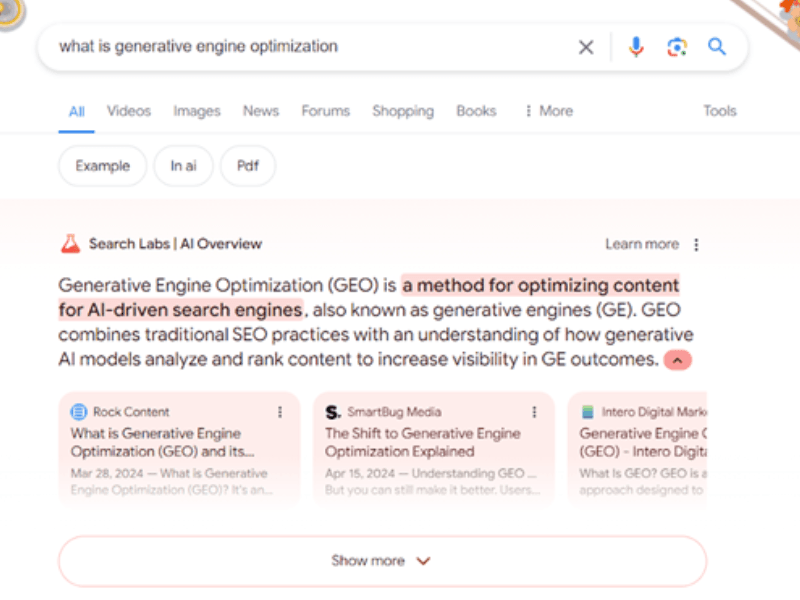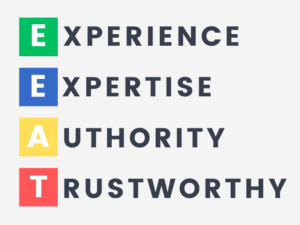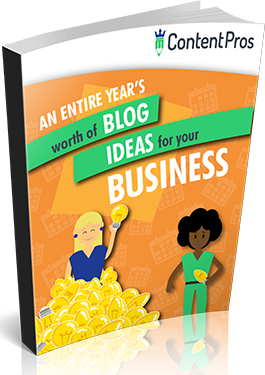Keep calm: Google just released an AI update that will impact SEO and search results. This update focuses specifically on generative engine optimization (GEO) and Google AI Overviews. Ultimately, this means a new era of SEO is on the horizon, and content creators are adapting.
Usually when SEO algorithm updates drop, marketers send themselves into a tailspin trying to preserve their rankings. But this time feels different: We’re seeing more opportunities to rank your content and get in front of users with high intent.
The first step is understanding what this update is about and how to prepare your content moving forward. Let’s unpack the concepts of GEO and Google AI Overviews and how you can leverage them in your content strategy.
What Is GEO?
Generative Engine Optimization, or GEO, is like SEO for AI-powered search engines. AI search engines are the next iteration of classics like Google and Bing, both of which are now infusing AI elements into their rankings and results.
GEO combines traditional SEO practices with AI to better understand the user’s intent and deliver relevant results. In addition to showcasing a list of search results, GEO also generates a response for the user, such as a brief answer to a question or a short description matching the query. It will also highlight related sources the user can click for more information.
It’s our belief that GEO is not replacing SEO, but rather augmenting it. It aims to provide a better search experience while also showcasing more brand-driven content on the SERPs.
What Are Google AI Overviews?
Google AI Overviews replaced Google Snippets in May 2024. As a prominent part of GEO, Overviews are displayed on the search results pages above the organic rankings. They look like this:

Here, you’ll see an AI-generated overview of the query (in this example, we used “What is generative engine optimization”), along with additional resources from real websites. Below the AI overview, you’ll see the organic list of websites for the search query and other Google features, such as People Also Ask and People Also Search For.
Put another way, appearing in an Overview is essentially getting AI to recommend your business.
Change is hard, especially when a Google update might impact your content (and all the time and money you’ve invested in it). But based on what we’re seeing, Google AI Overviews provide more opportunities for your content to rank — and rank higher than they would in organic results.
AI Overviews tend to list at least three sources below the generated text, as opposed to one source for Google Snippets. You don’t have to be the single most authoritative source. Instead, you can be shown alongside other authoritative sources, making it easier to earn impressions and clicks.
How to Optimize Your Content for Google AI Overviews
Just like you’d create a blog post or infographic for SEO, you can do the same for GEO. Generative engine optimization gives you a better chance of being one of the top sources Google’s AI recommends as part of its generated response.
Researchers from Princeton University, Georgia Tech, Allen Institute, and IIT Dehli put GEO and Google AI Overviews to the test to determine the best way to tap into this new feature. They found that applying the following techniques improved their appearances in search by 30-40%:
1. Cite Authoritative Sources
For years, SEOs have touted authoritative sources as a helpful ranking factor. The researchers confirmed the same to hold true for Google AI Overviews.
Citing authoritative sources means linking to external websites that have high traffic and/or high domain authority ratings. If you’re not sure a website qualifies as authoritative, you can use Moz to check the DA rating of a website before linking to it.
You want to affiliate your website with sites other people know and trust. This makes you more credible by extension, plus it shows you’ve done your research and care about the quality of the content you’re linking to.
2. Add Quotes from Subject Matter Experts
Similar to authoritative sources, adding quotes from subject matter experts can also increase the credibility of your content. These might be original quotes from your own interviews and research, or they might be repurposed quotes from other high-quality published interviews.
While speaking at Google’s I/O 2024 event, Google’s CEO reiterated the positive impact of the new AI Overviews feature:
“We’ve been testing this experience outside of Labs. And we’re encouraged to see not only an increase in Search usage, but also an increase in user satisfaction.” – Sundar Pichai
3. Add Statistics from Reputable Sources
Statistics can help support your ideas and show you’ve done your homework. However, there are right and wrong ways to go about linking to statistics.
Ideally, you’ll choose statistics that:
- Are recent (less than 1-2 years old)
- Come from the original source
- Aren’t hidden behind gated content
Remember, anyone can make up any number or figure to appear credible. If you find a statistic in an article that isn’t from the original source, try to trace its origin. See if the article linked to the stat or at least shared where the statistic came from. If the article doesn’t include a link, you can do a Google search for the statistic and see who else has published it.
Doing this extra bit of research ensures you’re not blindly sharing misinformation, plus it increases your credibility because you’ve taken time to vet the information.
4. Use Plain Language that Most People Can Understand
Large language models are one of the driving forces behind AI. People want to read the way they talk, which is why using a casual tone at a low reading level can help your rankings. Researchers found that speaking like a textbook did not improve AI rankings.
These models want to recommend people-first content, meaning content people understand and want to read. If it’s too authoritative, you risk alienating your audience as well as missing out on ranking opportunities.
To improve your content’s readability, use the Hemingway Editor app to score your content’s reading level. Hemingway also highlights areas of complexity and will show you in real time how your content improves as you make changes.
5. Use Question-and-Answer Formats in Content
Focusing again on plain language that real people use, Q & A formats can help algorithms align real queries with your content. Naturally incorporate questions into headings and the body of your content. Bonus points if your question is also an exact match for a long-tail keyword. Here’s an example:

6. Don’t Over-Optimize with Keywords
By now, we know that keyword stuffing isn’t helpful. There is such a thing as over-optimizing your content with keywords. AI search knows this, too, and doesn’t favor content with too many keywords. Be selective in choosing keywords—in many cases, less is more.
7. Create Thorough Content
Writing complete, helpful content continues to play a role in search rankings, including AI-powered search. People want to read content that clearly yet succinctly answers their questions, shows them how to do something, or otherwise helps them.
Follow this format even when there’s relatively little search volume for certain topics. This demonstrates your authority and helps algorithms learn more about what you do best.
No matter what topic you’re writing about, your content should leave the reader feeling satisfied, not asking more questions. This also gives AI models more context about your content, which can help you get in front of a relevant audience.
8. Continue Prioritizing EEAT
For years, link-building has been one of the most important ways to build authority. However, in recent months, Google has shifted the narrative to focus on E-E-A-T (Experience, Expertise, Authoritativeness, and Trustworthiness).

In the recent Google algorithm leak, we confirmed that authorship plays an important role in rankings. Combining this knowledge with E-E-A-T, you can stick with traditional link-building, but you should also go beyond backlinks and focus on mentions in visible, relevant places.
Getting published on other channels (think guest blog posts, expert round-ups, SME interviews, etc.) helps you build a digital profile of sorts. Algorithms can better understand your expertise based on where you’re published online, what you talk about, and who else you’re affiliated with. Even unlinked mentions can carry weight if they come from sources that are relevant to your industry.
If you’re proactive in building your profile across multiple channels and sites, you can more clearly define your business or brand, which may help in appearing in relevant AI search overviews.
9. Rely on Human Content Creators
While others are doubling down on AI tools, you can bet on humans to get ahead. AI-generated content is no better than the content it was trained with. It lacks the uniqueness that ultimately helps you rank above other content creators writing about similar topics.
AI is a valuable tool for generating topic ideas, creating outlines, and drafting social media posts. However, there are still many things that AI can’t do in content creation:
- AI can’t think like a user or optimizer.
- AI can’t place your keywords in precisely the right places.
- AI can’t infuse real emotion into your content.
There’s No Better Time to Invest in GEO
When Google first tested AI generative search results, many thought SEO would die. In fact, we’re seeing the opposite.
Google CEO Sundar Pichai shares that AI Overviews have increased search usage, which means more opportunities to get in front of a relevant audience.
Don’t let Google AI Overviews scare you—they’re here to help, and we are too. Contact us today to learn how we can empower your content strategy with expert, authoritative content writing.

